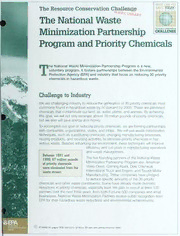
Resource conservation challenge : the National Waste Minimization Partnership Program and priority chemicals PDF
Preview Resource conservation challenge : the National Waste Minimization Partnership Program and priority chemicals
WHAT CAN YOU The Resource Conservation Challenge SAVE TODAY S M T W T F S wmrc library The National Waste Minimization Partnership RESOURCE CONSERVATION CHALLENGE Program and Priority Chemicals T he National Waste Minimization Partnership Program is a new, voluntary program. It fosters partnerships between the Environmental Protection Agency (EPA) and industry that focus on reducing 30 priority chemicals in hazardous waste. Challenge to Industry We are challenging industry to reduce the generation of 30 priority ohemicals most commonly found in hazardous waste by 50 percent by 2005. These are persistent chemicals that contaminate our land, air, water, plants, and animals. By achieving this goal, we will not only eliminate almost 76 million pounds of priority chemicals, but we also will save energy and money. To accomplish our goal of reducing priority chemicals, we are forming partnerships with companies, organizations, states, and tribes. We will use waste minimization techniques, such as substituting chemicals, changing manufacturing processes, reusing products, and recycling activities, to eliminate priority chemicals in haz¬ ardous waste. Besides enhancing our environment, these techniques will improve efficiency and cut costs in manufacturing operations and waste management. Between 1991 and The five founding partners of the National Waste 1998, 67 million pounds Minimization Partnership Program are: American of priority chemicals Video Glass, Corning Asahi, Dow Chemioal, were eliminated from the International Truck and Engine, and Toyota Motor waste stream. Manufacturing. These companies have pledged to reduce specific amounts of the 30 priority chemicals and other waste constituents. Some have already made dramatic reductions in priority chemicals, especially lead. We plan to recruit at least 100 partners over the next three years, from both Fortune 500 companies and small businesses. National Waste Minimization Partners receive public recognition from EPA for their hazardous waste reductions and environmental achievements. Printed on paper that contains at least 30 percent postconsumer fiber. Tracking Dur Progress Hazardous waste generation has significantly declined over the last 25 years. Our Waste Minimization Trends Report describes this decline in generation, and subse¬ quent management of hazardous waste priority chemicals. The Report uses data col¬ lected through the Toxic Release Inventory (TRI) from 1991-1998. TRI data identifies the chemical volumes most likely associated with hazardous waste generation. TRI data showed a 44 percent reduction in disposal of 20 of the 30 priority chemi¬ cals—from an estimated 152 million pounds in 1991 to an estimated 85 million pounds in 1998—a decline of about 67 million pounds. Some industries showing more dramatic reductions were inorganic chemical manufacturing, battery manufactur¬ ing, and alkali and chlorine manufacturing. We are enlisting industries that produce the highest volumes of the 30 priority chemicals, which include, metal smelters and refin¬ ers, steel mills and blast furnaces, glass and glassware manufacturers, and petroleum refiners, among others. We believe the National Waste Minimization Partnership Program will not only achieve great reductions in the amount of hazardous waste we generate, but also place more emphasis on conserving our natural resources. For More Information More information on the National Waste Minimization Partnership Program and the Waste Minimization Trends Report is available at www.epa.gov/epaoswer/osw/ conserve/index.htm. We also would like your suggestions on how we can meet the national reduction goal. Email us at oswchallenge ©epa.gov or write to: U.S. EPA 1200 Pennsylvania Avenue, NW (5305W) Washington, DC 20460 Attn; RCC You can also obtain information by calling the RCRA Call Center at 703 412-9810 or TDD 703 412-3323 (hearing impaired) if you are live within the Washington Metropolitan area. Call 800 424-9346 or TDD 800 553-7672, if you are a long-distance caller. Solid Waste and Emergency Response (5305W) EPA530-F-02-035 www.epa.gov/osw
